
Panarthropoda is a proposed animal clade containing the extant phyla Arthropoda, Tardigrada and Onychophora. Panarthropods also include extinct marine legged worms known as lobopodians ("Lobopodia"), a paraphyletic group where the last common ancestor and basal members (stem-group) of each extant panarthropod phylum are thought to have risen. However the term "Lobopodia" is sometimes expanded to include tardigrades and onychophorans as well.
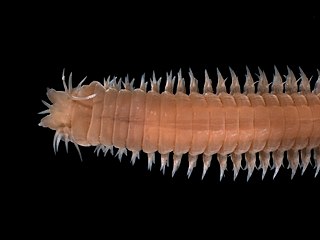
The Trochozoa are a proposed Lophotrochozoa clade that is a sister clade of Bryozoa. The clade would include animals in six phyla: the Nemertea, the Annelida, the Cycliophora, the Mollusca, and the two Brachiozoan phyla, Brachiopoda and Phoronida.
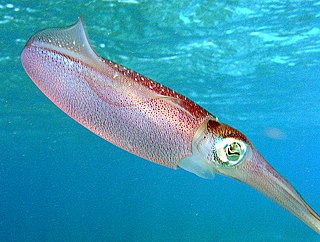
Lophotrochozoa is a clade of protostome animals within the Spiralia. The taxon was established as a monophyletic group based on molecular evidence. The clade includes animals like annelids, molluscs, bryozoans, brachiopods, and platyhelminthes.
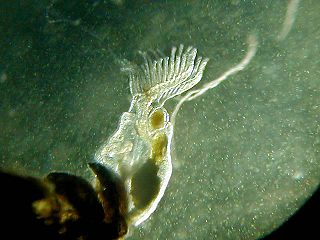
The lophophore is a characteristic feeding organ possessed by four major groups of animals: the Brachiopoda, Bryozoa, Hyolitha, and Phoronida, which collectively constitute the protostome group Lophophorata. All lophophores are found in aquatic organisms.

Albugo candida, commonly known as white rust or white blister rust, is an obligate plant pathogen in the family Albuginaceae that infects Brassicaceae species. It has a relatively smaller genome than other oomycetes.
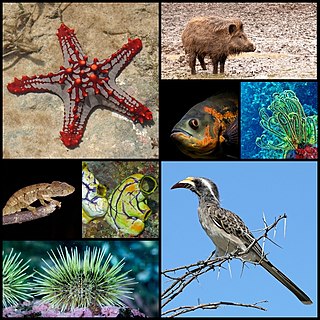
Deuterostomia are animals typically characterized by their anus forming before their mouth during embryonic development. The group's sister clade is Protostomia, animals whose digestive tract development is more varied. Some examples of deuterostomes include vertebrates, sea stars, and crinoids.

Phoronids are a small phylum of marine animals that filter-feed with a lophophore, and build upright tubes of chitin to support and protect their soft bodies. They live in most of the oceans and seas, including the Arctic Ocean but excluding the Antarctic Ocean, and between the intertidal zone and about 400 meters down. Most adult phoronids are 2 cm long and about 1.5 mm wide, although the largest are 50 cm long.
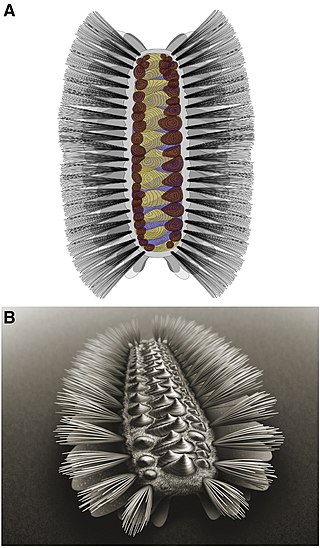
Tommotiids are an extinct group of Cambrian invertebrates thought to be early lophophorates.

The origin of the brachiopods is uncertain; they either arose from reduction of a multi-plated tubular organism, or from the folding of a slug-like organism with a protective shell on either end. Since their Cambrian origin, the phylum rose to a Palaeozoic dominance, but dwindled during the Mesozoic.
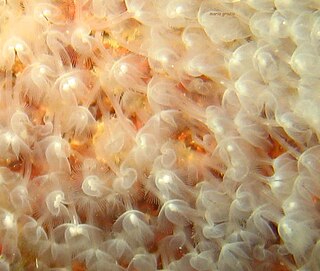
Brachiozoa is a grouping of lophophorate animals including Brachiopoda and Phoronida. It also includes their ancestors, the extinct tommotiids.

The Spiralia are a morphologically diverse clade of protostome animals, including within their number the molluscs, annelids, platyhelminths and other taxa. The term Spiralia is applied to those phyla that exhibit canonical spiral cleavage, a pattern of early development found in most members of the Lophotrochozoa.

Phascolosomatidea is a subclass of the class Sipuncula, the peanut worms, containing two orders:-
An overlapping gene is a gene whose expressible nucleotide sequence partially overlaps with the expressible nucleotide sequence of another gene. In this way, a nucleotide sequence may make a contribution to the function of one or more gene products. Overlapping genes are present and a fundamental feature of both cellular and viral genomes. The current definition of an overlapping gene varies significantly between eukaryotes, prokaryotes, and viruses. In prokaryotes and viruses overlap must be between coding sequences but not mRNA transcripts, and is defined when these coding sequences share a nucleotide on either the same or opposite strands. In eukaryotes, gene overlap is almost always defined as mRNA transcript overlap. Specifically, a gene overlap in eukaryotes is defined when at least one nucleotide is shared between the boundaries of the primary mRNA transcripts of two or more genes, such that a DNA base mutation at any point of the overlapping region would affect the transcripts of all genes involved. This definition includes 5′ and 3′ untranslated regions (UTRs) along with introns.
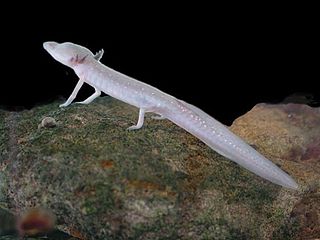
Troglomorphism is the morphological adaptation of an animal to living in the constant darkness of caves, characterised by features such as loss of pigment, reduced eyesight or blindness, and frequently with attenuated bodies or appendages. The terms troglobitic, stygobitic, stygofauna, troglofauna, and hypogean or hypogeic, are often used for cave-dwelling organisms.

ParaHoxozoa is a clade of animals that consists of Bilateria, Placozoa, and Cnidaria. The relationship of this clade relative to the two other animal lineages Ctenophora and Porifera is debated. Some phylogenomic studies have presented evidence supporting Ctenophora as the sister to Parahoxozoa and Porifera as the sister group to the rest of animals. Some studies have presented evidence supporting Porifera as the sister to Parahoxozoa and Ctenophora as the sister group to the rest of animals.
The Kryptotrochozoa are a proposed Lophotrochozoa clade. It consists of the Nemertea and Lophophorata. It is controversial.
Amanda M. Hulse-Kemp is a computational biologist with the United States Department of Agriculture – Agricultural Research Service. She works in the Genomics and Bioinformatics Research Unit and is stationed on the North Carolina State University campus in Raleigh, North Carolina.
Fungal genomes are among the smallest genomes of eukaryotes. The sizes of fungal genomes range from less than 10 Mbp to hundreds of Mbp. The average genome size is approximately 37 Mbp in Ascomycota, 47 Mbp in Basidiomycota and 75 Mbp in Oomycota. The sizes and gene numbers of the smallest genomes of free-living fungi such as those of Wallemia ichthyophaga, Wallemia mellicola or Malassezia restricta are comparable to bacterial genomes. The genome of the extensively researched yeast Saccharomyces cerevisiae contains approximately 12 Mbp and was the first completely sequenced eukaryotic genome. Due to their compact size fungal genomes can be sequenced with less resources than most other eukaryotic genomes and are thus important models for research. Some fungi exist as stable haploid, diploid, or polyploid cells, others change ploidy in response to environmental conditions and aneuploidy is also observed in novel environments or during periods of stress.
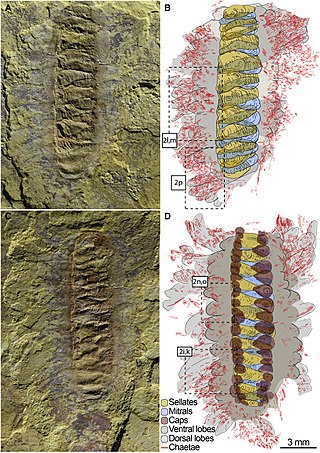
Wufengella is a genus of extinct camenellan "tommotiid" that lived during the Early Cambrian. Described in 2022, the only species Wufengella bengtsonii was discovered from the Maotianshan Shales of Chiungchussu (Qiongzhusi) Formation in Yunnan, China. The fossil indicates that the animal was an armoured worm that close to the common ancestry of the phyla Phonorida, Brachiozoa and Bryozoa, which are collectively grouped into a clade called Lophophorata.
















